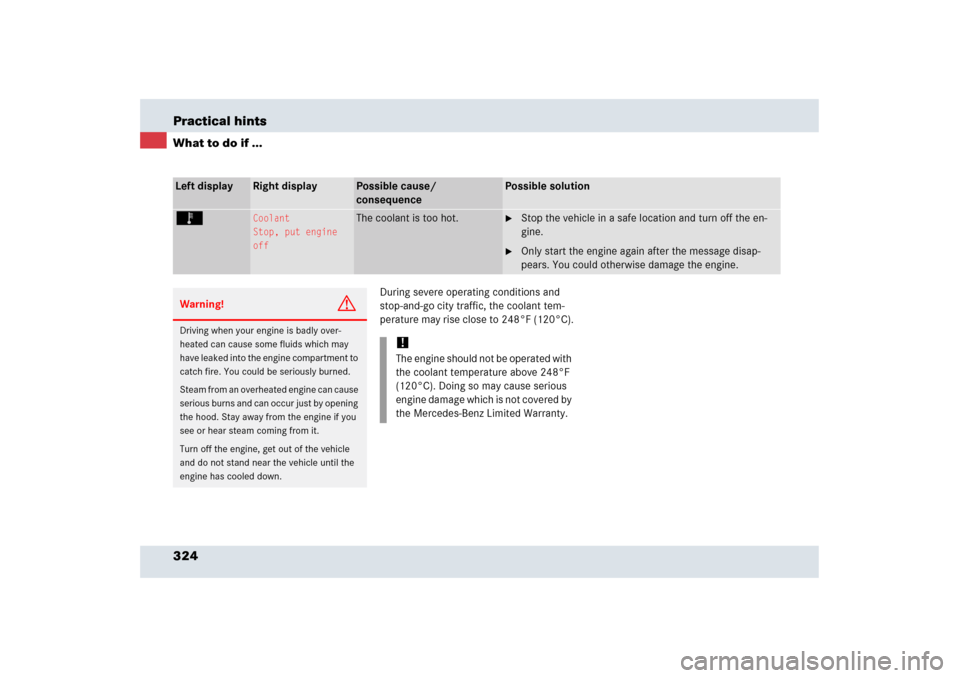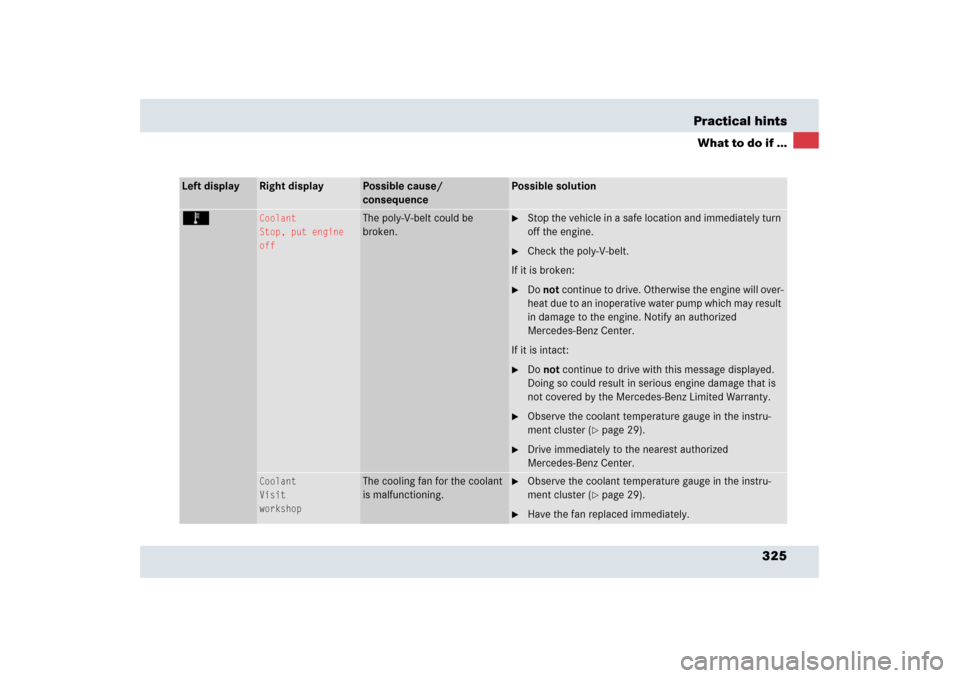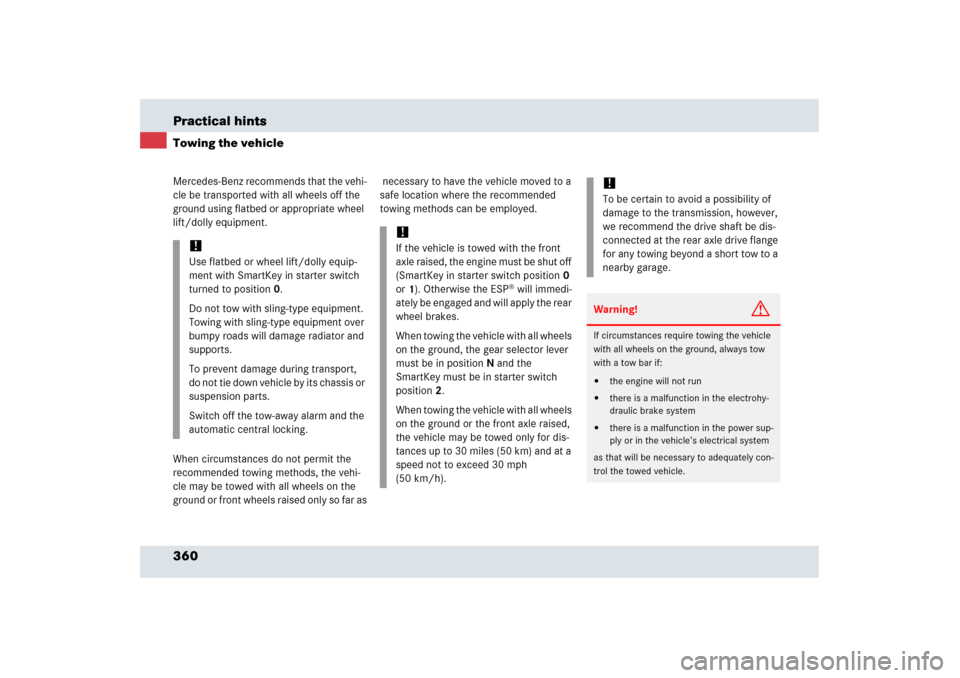Page 323 of 409
322 Practical hintsWhat to do if ...Left display
Right display
Possible cause/
consequence
Possible solution
;
(USA only)
3
(Canada only)
Brakes overheated
Drive on, but with
even greater care
The brake system is overheated
due to an excessive load on the
brakes.
�
Relieve the load on the brake system.
�
Drive more smoothly and think ahead to avoid
unnecessary braking.
�
When driving down steep grades, shift into a
lower gear to use the engine’s braking power
(�page 170).
�
Cautiously continue driving so that the air
stream will cool down the brakes.
Release
parking brake
You are driving with the parking
brake set.
�
Release the parking brake (
�page 50).
Service brake
Visit
workshop
There are malfunctions, but the
electrohydraulic brake system
is operating normally.
�
Visit an authorized Mercedes-Benz Center im-
mediately.
Page 324 of 409
323 Practical hints
What to do if ...
Left display
Right display
Possible cause/
consequence
Possible solution
B
Coolant
Check level
The coolant level is too low.
�
Add coolant (
�page 250).
�
If you have to add coolant frequently, have the cooling
system checked by an authorized Mercedes-Benz Center
immediately.
Warning!
G
Do not spill antifreeze on hot engine parts.
Antifreeze contains ethylene glycol which
may burn if it comes into contact with hot
engine parts. You can be seriously burned.
!Do not ignore the low engine coolant
level warning. Extended driving with
the message and symbol displayed
may cause serious engine damage not
covered by the Mercedes-Benz Limited
Warranty.
Do not drive without sufficient amount
of coolant in the cooling system. The
engine will overheat causing major
engine damage.
Page 325 of 409

324 Practical hintsWhat to do if ...
During severe operating conditions and
stop-and-go city traffic, the coolant tem-
perature may rise close to 248°F (120°C).
Left display
Right display
Possible cause/
consequence
Possible solution
Ï
Coolant
Stop, put engine
off
The coolant is too hot.
�
Stop the vehicle in a safe location and turn off the en-
gine.
�
Only start the engine again after the message disap-
pears. You could otherwise damage the engine.
Warning!
G
Driving when your engine is badly over-
heated can cause some fluids which may
have leaked into the engine compartment to
catch fire. You could be seriously burned.
Steam from an overheated engine can cause
serious burns and can occur just by opening
the hood. Stay away from the engine if you
see or hear steam coming from it.
Turn off the engine, get out of the vehicle
and do not stand near the vehicle until the
engine has cooled down.
!The engine should not be operated with
the coolant temperature above 248°F
(120°C). Doing so may cause serious
engine damage which is not covered by
the Mercedes-Benz Limited Warranty.
Page 326 of 409

325 Practical hints
What to do if ...
Left display
Right display
Possible cause/
consequence
Possible solution
Ï
Coolant
Stop, put engine
off
The poly-V-belt could be
broken.
�
Stop the vehicle in a safe location and immediately turn
off the engine.
�
Check the poly-V-belt.
If it is broken:
�
Do not continue to drive. Otherwise the engine will over-
heat due to an inoperative water pump which may result
in damage to the engine. Notify an authorized
Mercedes-Benz Center.
If it is intact:
�
Do not continue to drive with this message displayed.
Doing so could result in serious engine damage that is
not covered by the Mercedes-Benz Limited Warranty.
�
Observe the coolant temperature gauge in the instru-
ment cluster (
�page 29).
�
Drive immediately to the nearest authorized
Mercedes-Benz Center.
Coolant
Visit
workshop
The cooling fan for the coolant
is malfunctioning.
�
Observe the coolant temperature gauge in the instru-
ment cluster (
�page 29).
�
Have the fan replaced immediately.
Page 329 of 409
328 Practical hintsWhat to do if ...Left display
Right display
Possible cause/
consequence
Possible solution
±
Engine
Service
There may be a malfunction in
the �
fuel injection system
�
ignition system
�
exhaust system
�
fuel system
�
Have the engine checked by an authorized
Mercedes-Benz Center immediately.
:
Engine oil pressure
Visit
workshop
There is no oil in the engine.
There is a danger of engine
damage.
�
Stop your vehicle immediately in a safe location.
�
Switch off the engine.
�
Notify an authorized Mercedes-Benz Center
immediately.
!The engine oil level warning should not
be ignored. Extended driving with the
symbol displayed could result in seri-
ous engine damage that is not covered
by the Mercedes-Benz Limited
Warranty.
Page 352 of 409

351 Practical hints
Flat tire
�Flat tire
The vehicle is equipped with the TIREFIT
kit.Preparing the vehicle�
Park the vehicle in a safe distance from
moving traffic on a hard, flat surface
when possible.
�
Turn on the hazard warning flashers.
�
Turn the steering wheel so that the
front wheels are in a straight ahead po-
sition.
�
Set the parking brake.
�
Move the gear selector lever to P.
�
Turn off the engine (
�page 58).
�
Remove the SmartKey from the starter
switch.
�
Open the driver’s door.
�
Have any passenger exit the vehicle at
a safe distance from the roadway.
Sealing tires with TIREFIT kit
Small tire punctures, particularly those in
the tread, can be sealed with TIREFIT.
TIREFIT can be used in ambient tempera-
tures down to -4°F (-20°C).
�
Foreign objects (e.g. screws or nails)
should not be removed from the tire.
�
Take TIREFIT, the sticker, and the elec-
tric air pump out of the trunk.
!A wheel change should only be carried
out at an authorized Mercedes-Benz
Center. Otherwise there is a danger of
damaging the vehicle by jacking it up
incorrectly.
iOpen door only when conditions are
safe to do so.Warning!
G
Keep TIREFIT away from sparks, open flame
or heat source.
Do not smoke.
Warning!
G
TIREFIT is a limited repair device. TIREFIT
cannot be used for cuts or punctures larger
than approximately 0.16 in (4 mm) and tire
damage caused by driving with extremely
low tire inflation pressure, or on a flat tire, or
a damaged wheel.
Do not drive the vehicle under such circum-
stances.
Contact your nearest Mercedes-Benz
Center for assistance or call Roadside
Assistance. !After using TIREFIT, the tire inflation
pressure sensor may have to be re-
placed.
��
Page 361 of 409

360 Practical hintsTowing the vehicleMercedes-Benz recommends that the vehi-
cle be transported with all wheels off the
ground using flatbed or appropriate wheel
lift/dolly equipment.
When circumstances do not permit the
recommended towing methods, the vehi-
cle may be towed with all wheels on the
ground or front wheels raised only so far as necessary to have the vehicle moved to a
safe location where the recommended
towing methods can be employed.
!Use flatbed or wheel lift/dolly equip-
ment with SmartKey in starter switch
turned to position0.
Do not tow with sling-type equipment.
Towing with sling-type equipment over
bumpy roads will damage radiator and
supports.
To prevent damage during transport,
do not tie down vehicle by its chassis or
suspension parts.
Switch off the tow-away alarm and the
automatic central locking.
!If the vehicle is towed with the front
axle raised, the engine must be shut off
(SmartKey in starter switch position0
or1). Otherwise the ESP
® will immedi-
ately be engaged and will apply the rear
wheel brakes.
When towing the vehicle with all wheels
on the ground, the gear selector lever
must be in positionN and the
SmartKey must be in starter switch
position2.
When towing the vehicle with all wheels
on the ground or the front axle raised,
the vehicle may be towed only for dis-
tances up to 30 miles (50 km) and at a
speed not to exceed 30 mph
(50 km/h).
!To be certain to avoid a possibility of
damage to the transmission, however,
we recommend the drive shaft be dis-
connected at the rear axle drive flange
for any towing beyond a short tow to a
nearby garage. Warning!
G
If circumstances require towing the vehicle
with all wheels on the ground, always tow
with a tow bar if:�
the engine will not run
�
there is a malfunction in the electrohy-
draulic brake system
�
there is a malfunction in the power sup-
ply or in the vehicle’s electrical system
as that will be necessary to adequately con-
trol the towed vehicle.
Page 362 of 409

361 Practical hints
Towing the vehicle
Prior to towing the vehicle with all wheels on
the ground, make certain that the SmartKey
is in starter switch position2.
If the SmartKey is left in starter switch
position0 for an extended period of time, it
can no longer be turned in the switch. In this
case, the steering is locked. To unlock, re-
move SmartKey from starter switch and re-
insert.iTo signal turns while being towed with
the hazard warning flasher in use, turn
SmartKey in starter switch to
position2 and activate the combina-
tion switch for the left or right turn sig-
nal in the usual manner – only the
selected turn signal will operate.
Upon canceling the turn signal, the haz-
ard warning flasher will operate again.
Warning!
G
The brake system requires electrical power
to operate.
A malfunction in the vehicle’s power supply
or electrical system may impair brake sys-
tem operation and switch it into its emer-
gency operation mode. To brake, the driver
must then apply significantly greater brake
pedal pressure and depress the pedal much
further to obtain the expected braking ef-
fect. If necessary, apply full pressure to the
brake pedal. Brakes are only applied to the
front wheels. Stopping distance is in-
creased! Adapt your driving style according-
ly. For more information, see
“Electrohydraulic brake system”
(�page 84).
With the engine not running, there is no
power assistance for the brake and steering
systems. In this case, it is important to keep
in mind that a considerably higher degree of
effort is necessary to brake and steer the ve-
hicle. Adapt your driving accordingly.
!Towing of the vehicle should only be
done using the properly installed tow-
ing eye bolt. Never attach tow cable,
tow rope or tow rod to the vehicle chas-
sis, frame or suspension parts.iWhen towing the vehicle with all wheels
on the ground, please note the follow-
ing:
With the automatic central locking acti-
vated and the SmartKey in starter
switch position2 the vehicle doors
lock if the left front wheel as well as the
right rear wheel are turning at vehicle
speeds of approximately 9 mph
(15 km/h) or more.
To prevent the vehicle door locks from
locking, deactivate the automatic
central locking (
�page 137).